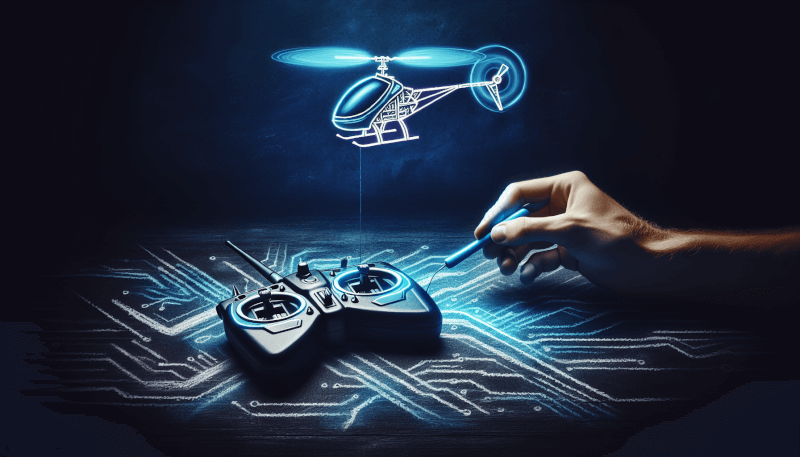If you’re an avid RC helicopter enthusiast, you know how frustrating it can be when your prized model decides to take an unplanned flight on its own. This phenomenon, known as a flyaway, is a common occurrence in the RC community and can result in losing your cherished helicopter forever. But fear not! In this article, we’ll share some top tips to help you prevent RC heli flyaways and ensure that your valuable investment stays under your control at all times. So, buckle up and get ready to discover some effective strategies that will keep your RC heli firmly grounded where it belongs!

Choose the Right Location for Flying
When it comes to flying your RC helicopter, choosing the right location is crucial. One of the key factors to consider is the weather conditions. It is important to avoid flying in strong winds, rain or snow, as these conditions can greatly affect the stability and control of your aircraft. Opt for calm and clear weather conditions to ensure a safe and enjoyable flight.
Another aspect to consider when selecting a flying location is avoiding obstacles. Flying near trees, buildings, or other structures increases the risk of crashes and damage to your helicopter. Look for open spaces such as parks or fields where there are no potential obstacles that can interfere with your flight path. This will give you ample room to maneuver your helicopter without any obstructions.
Lastly, ensure that the flying location provides sufficient open space. Flying in cramped or crowded areas increases the risk of collisions with other objects or people. Choose a location where you have enough space to safely fly your RC helicopter without endangering others or causing damage to property. This will not only ensure the safety of those around you but also increase your chances of having a successful flight.
Perform a Pre-flight Check
Before taking off, it is essential to perform a thorough pre-flight check to ensure the safety and proper functioning of your aircraft. Start by inspecting the helicopter for any damages. Look for any cracks, loose parts, or signs of wear and tear. It is crucial to address any issues before flying, as they can lead to unpredictable behavior or even accidents during flight.
Checking the battery levels is another critical step in the pre-flight check. Make sure the battery is fully charged and has sufficient capacity to support your desired flight duration. A low battery can lead to sudden power loss, causing your helicopter to crash. Ensure you have enough power for a safe and controlled flight.
Additionally, it is important to check all controls and connections to ensure they are functioning properly. Verify that the remote control is responsive and all buttons and switches are working as intended. Check that the connections between the helicopter and the remote control are secure and stable. This will help prevent any malfunctions or loss of control during the flight.
Maintain a Strong GPS Signal
Having a strong and stable GPS signal is crucial for safe and controlled flying. Before taking off, wait until you have a stable GPS signal. This will provide accurate positioning information and improve the overall performance of your RC helicopter. Trying to fly without a stable GPS signal can lead to unpredictable behavior or even loss of control over your aircraft.
Furthermore, it is advisable to avoid flying in areas with weak GPS signal coverage. Poor signal reception can result in inaccuracies in positioning and navigation, increasing the risk of accidents or flyaways. Choose locations with good GPS signal strength to ensure a safe and reliable flight.
In addition, it is essential to properly calibrate the GPS before each flight. This calibration process helps the helicopter accurately interpret the GPS data and ensures it is providing accurate information to the flight controller. Follow the manufacturer’s instructions on how to properly calibrate the GPS to avoid any errors or inaccuracies in the navigation system.
Calibrate the Compass
Calibrating the compass of your RC helicopter is crucial for accurate navigation and flight control. The compass helps the aircraft determine its orientation and direction, ensuring smooth and precise flight maneuvers. Follow the manufacturer’s instructions on how to calibrate the compass properly.
When calibrating the compass, it is important to avoid metallic objects or structures as they can interfere with the calibration process, leading to inaccurate readings. Choose an open area away from any potential sources of interference to ensure a successful calibration. By calibrating the compass in a suitable location, you can rely on accurate navigation data during your flight.

Use Fail-Safe Systems
Fail-safe systems provide an added layer of safety and control in case of any signal loss or interference. It is important to activate fail-safe mode in your RC helicopter to ensure a controlled descent and prevent flyaways in case of signal loss. This mode helps your aircraft return to a preset safe altitude and maintain a stable hover until the signal is regained.
When setting the fail-safe return-to-home altitude, ensure it is at a safe height to avoid any potential obstacles during the return journey. Take into consideration the surrounding terrain and any potential hazards that may be present. Setting the altitude too low can result in collisions, while setting it too high may lead to the aircraft being lost or out of sight.
Make sure to properly configure the fail-safe functions in your helicopter according to the manufacturer’s instructions. Adjust settings such as return-to-home altitude, return speed, and other parameters as advised. This will ensure that your fail-safe system operates correctly and provides a reliable and safe option in case of emergencies.
Monitor Battery Levels
Monitoring the battery levels of your RC helicopter is crucial for a safe and successful flight. Keeping an eye on the remaining battery capacity allows you to plan your flight duration accordingly and prevent the battery from reaching critically low levels. Flying until the battery is fully depleted can result in sudden power loss, causing your helicopter to crash or become uncontrollable.
To stay informed about the battery levels during flight, consider setting up a low voltage warning. This feature will alert you when the battery reaches a predetermined voltage, indicating it is time to land and recharge or replace the battery. Set the warning threshold according to the specifications of your battery to ensure accurate and timely notifications.
It is important to note that batteries perform differently in varying weather conditions. Extreme temperatures can affect the performance and overall lifespan of your battery. Therefore, it is advised to avoid flying in extremely hot or cold weather, as it can have adverse effects on the battery’s performance and longevity.

Practice Proper Controller Usage
Using the controller correctly and effectively is vital for smooth and precise control over your RC helicopter. Properly holding the controller helps you maintain a comfortable grip and allows for better control during flight. Hold the controller with a relaxed grip, ensuring all fingers are securely placed on the joysticks and buttons.
Keep your fingers away from the sensitive buttons to avoid accidental inputs that can lead to unexpected behavior of your helicopter. Accidental button presses can result in unintentional movements or changes in flight modes, compromising the safety and control of your aircraft. By keeping your fingers away from sensitive buttons, you reduce the risk of such incidents occurring.
Ensure your inputs on the controller are smooth and precise. Avoid sudden or jerky movements that can cause the helicopter to become unstable or lose control. Practice gradual and controlled inputs to achieve the desired flight maneuvers smoothly. By mastering proper controller usage, you can have better control over your RC helicopter and enhance your flight experience.
Avoid Interference
Interference from other radio frequency sources can cause disruptions in the signal between your remote control and the helicopter, leading to loss of control or unpredictable behavior. To prevent interference, stay away from areas where other devices operating on similar radio frequencies are present. These can include Wi-Fi routers, Bluetooth devices, or other remote-controlled devices.
Flying near power lines or strong magnetic fields can also introduce interference and affect the performance and stability of your RC helicopter. Avoid these areas as they can result in unexpected flight behavior or loss of control over your aircraft. Be aware of your surroundings and choose a location that minimizes the risk of interference.
When selecting a flying location, it is advisable to check for radio interference in the area. Use a radio frequency scanner or a dedicated app to identify any potential sources of interference. By being aware of potential interference sources, you can select a suitable location that reduces the risks associated with signal disruptions.

Follow Manufacturer Recommendations
To ensure optimal performance, safety, and longevity of your RC helicopter, it is essential to follow the manufacturer’s recommendations. Reading and understanding the user manual is a crucial step in familiarizing yourself with the helicopter’s features, controls, and maintenance requirements. The manual provides valuable information on how to operate and maintain your aircraft correctly.
Following recommended maintenance procedures is vital to keep your RC helicopter in good working condition. Regularly inspecting and cleaning the helicopter, checking the moving parts, and lubricating them as needed are essential maintenance tasks. Additionally, follow the manufacturer’s guidelines on when and how to perform routine maintenance such as motor or propeller replacements.
Updating the firmware and software as advised by the manufacturer is another important aspect to consider. These updates often include bug fixes, performance improvements, and new features that enhance the overall functionality of your RC helicopter. Staying up-to-date with the latest updates ensures you have the best possible flying experience and minimizes the risk of any known issues.
Stay Alert and Prepared
Throughout your flight, it is important to stay alert and be prepared to adapt to changing conditions. Monitor the flight conditions closely and make adjustments as necessary. Changes in wind speed or direction, temperature, or other environmental factors can affect the stability and control of your RC helicopter. Stay vigilant and make flight adjustments to maintain a safe and enjoyable experience.
It is also essential to be ready to take immediate control in case of emergencies. Develop quick reflexes and practice emergency procedures to react promptly to any unforeseen situation. By staying calm and composed, you can effectively handle emergencies and prevent potential accidents or damages to your aircraft.
Lastly, it is important to stay focused and avoid distractions during flight. Flying an RC helicopter requires concentration and attention to detail. Distractions can lead to errors in judgment, resulting in accidents or flyaways. Keep your focus on the helicopter and the flight conditions, minimizing distractions by avoiding conversations or attending to other tasks while flying.
In conclusion, by choosing the right location, performing a pre-flight check, maintaining a strong GPS signal, calibrating the compass, using fail-safe systems, monitoring battery levels, practicing proper controller usage, avoiding interference, following manufacturer recommendations, and staying alert and prepared, you can enhance the safety, performance, and overall enjoyment of your RC helicopter flying experience. Remember to always prioritize safety and adhere to regulations and guidelines set forth by local authorities. Happy flying!



